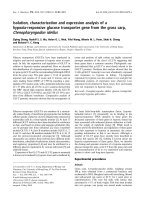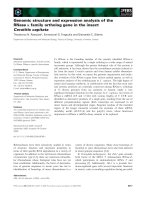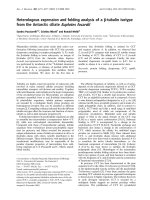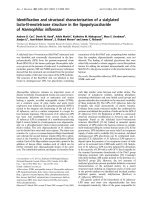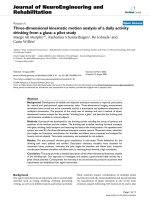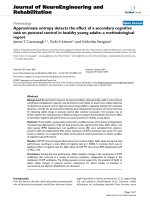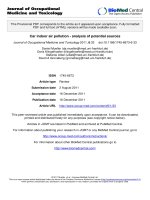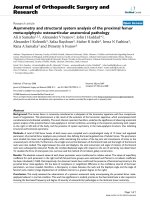Báo cáo hóa học: " Bit Error Rate Performance Analysis of a Threshold-Based Generalized Selection Combining Scheme in Nakagami " docx
Bạn đang xem bản rút gọn của tài liệu. Xem và tải ngay bản đầy đủ của tài liệu tại đây (652.04 KB, 7 trang )
EURASIP Journal on Wireless Communications and Networking 2005:2, 242–248
c
2005 Hindawi Publishing Corporation
Bit Error Rate Performance Analysis of a
Threshold-Based Generalized Selection Combining
Scheme in Nakagami Fading Channels
Ahmed Iyanda Sulyman
Electrical and Computer Engineering Department, Faculty of Applied Science, Queen’s University,
Kingston, ON, Canada K7L 3N6
Email:
Maan Kousa
Electrical Engineering Department, College of Engineering Sciences, King Fahd University of Petroleum & Minerals,
Dhahran 31261, Saudi Arabia
Email:
Received 2 September 2004; Revised 25 January 2005; Recommended for Publication by C. C. Ko
The severity of fading on mobile communication channels calls for the combining of multiple diversity sources to achieve ac-
ceptable error rate performance. Traditional approaches perform the combining of the different diversity sources using either the
conventional selective diversity combining (CSC), equal-gain combining (EGC), or maximal-ratio combining (MRC) schemes.
CSC and MRC are the two extremes of compromise between performance quality and complexity. Some researches have proposed
a generalized selection combining scheme (GSC) that combines the best M branches out of the L available diversity resources
(M
≤ L). In this paper, we analyze a generalized selection combining scheme based on a threshold criterion rather than a fixed-
size subset of the best channels. In this scheme, only those diversity branches whose energy levels are above a specified threshold
are combined. Closed-form analytical solutions for the BER performances of this scheme over Nakagami fading channels are
derived. We also discuss the merits of this scheme over GSC.
Keywords and phrases: diversity systems, generalized selection combining, threshold-based GSC, mobile communications,
Nakagami-m fading.
1. INTRODUCTION
Diversity techniques are based on the notion that errors
occurinreceptionwhenthechannelisindeepfade—a
phenomenon more pronounced in mobile communication
channels. Therefore, if the receiver is supplied with several
replicas, say L, of the same information signal transmitted
over independently fading channels, the probability that all
the L independently fading replicas fade below a critical value
is p
L
(where p is the probability that any one signal will
fade below the critical value). The bit error rate (BER) of
the system is thus improved without increasing the transmit-
ted power [1]. This is traditionally referred to as the diver-
sity gain of the system. Most diversity considerations have
always assumed that the spatial separations among the (mul-
This is an open access article distributed under the Creative Commons
Attribution License, which permits unrestricted use, distribution, and
reproduction in any medium, provided the original work is properly cited.
tiple) diversit y antennas are large enough so that the di-
versity branches experience uncorrelated fading, and there-
fore the signals received from the different diversity anten-
nas are independent. In some practical mobile systems; how-
ever, large antenna spacings are not feasible, and therefore
the fading statistics of the diversity branches in such cases
may be correlated. The impact of fading correlation on the
performance of diversity systems has been well studied in the
literature (see, e.g., [2, 3] and references therein). The gen-
eral conclusion from these studies is that the diversity gain
of the system is reduced when the diversity branches are cor-
related. The severity of this performance gain reduction is
usually in correspondence with the level of the fading cor-
relations among the diversity channels [2, 3]. In this work,
however, we focus mainly on the case of uncorrelated diver-
sity branches.
A crucial issue in diversity system is how to combine
the available diversity branches in order to achieve opti-
mum performance within acceptable complexity. The three
BER Performance Analysis of T-GSC in Nakagami Channels 243
traditional combiners are conventional selective combiner
(CSC) which selects the signal from that diversity branch
with the largest instantaneous SNR; equal-gain combiner
(EGC) which coherently combines all L diversity branches
weighting each with equal gain; and maximal-ratio combiner
(MRC) which coherently combines all L diversity branches
but weighs each w ith the respective ga in of the branch. CSC
gives the most inferior BER performance, MRC gives the best
and the optimum performance, and EGC has a performance
quality in between these two [1].
CSC and MRC are the two extremes of complexity-
quality tradeoff. CSC on one end is extremely simple, but
the contributions from the other branches are wasted, ir-
respective of their strength. MRC on the other end com-
bines the outcome of all branches regardless of how poor
some of them may be, resulting in the best possible combin-
ing performance gain. The cost for this performance is the
heavy processing complexity and extremely complicated cir-
cuitry required for phase coherence and amplitude estima-
tion on each branch. It should be noted that the lower the
received SNR, the less efficient the phase and amplitude esti-
mation circuit will be; therefore pr esence of accurate chan-
nel state information, often presumed in analytical proce-
dures, will not be valid for such branches. Also, processing
power a nd other resources dissipated into combining very
weak branches are more costly for wireless and high-order di-
versity systems than the marginal contribution such branches
make to the total combined SNR. MRC is known to be opti-
mal in the BER performance sense. However, when both the
BER performance and complexity should be considered, as is
the case in mobile systems, then a scheme that has good bal-
ance between BER performance and complexity is required.
Mobile units using high-order receiver diversity can rarely af-
ford MRC because of power limitations. In addressing this
problem, [4] proposes a suboptimal scheme that retains most
of the advantages of the MRC scheme, and has been widely
studied [5, 6, 7].
The scheme proposed in [4] combines a fixed number
of branches, say M, that have the largest instantaneous SNR
out of the L available branches. As 1 ≤ M ≤ L, the scheme
was called a generalized diversity selection combining (GSC)
scheme; M = 1 corresponds to CSC, while M = L corre-
sponds to MRC. Here we refer to that scheme as M-GSC (i.e.,
M-based GSC).
Combining a fixed number of branches, however, has ob-
vious shor tcomings. At times of deep fade, some of the M
selected branches will still have marginal contribution to the
total combined energy and they could be discarded to sim-
plify processing. At other times when the channels are good,
some of the L − M discarded branches, although inferior
to the M selected branches, have significant contribution,
and combining them will then be advantageous. An M-GSC
scheme cannot make any advantage of such improvements
in channel conditions since M is fixed, and the remaining
L − M branches must be discarded regardless of their energy
levels. Furthermore, we show later that M-GSC incurs a ma-
jor processing complexity increase in ordering the branches’
SNRs.
The authors have proposed a threshold-based generalized
selection combining (T-GSC) scheme that overcomes the
aforementioned shortcomings [8]. The T-GSC scheme com-
bines all the strong diversity branches available at any time
instant, discarding only the weak ones. The proposed scheme
is more suitable for mobile channels, which frequently and
intermittently improve and degrade during usage, and where
power resource savings are critically important and must be
made without compromising performance quality. The BER
performance of T-GSC was simulated over a Nakagami fad-
ing environment, and compared with M-GSC. Apparently,
the system in [8] has attracted other researchers [9, 10]. In
[10], Simon and Alouini analyzed the system for Rayleigh
fading channels with a slight modification to the threshold
definition.
In this work, we extend our work in [8] by providing a
detailed analysis of the BER performance of T-GSC over Nak-
agami fading channels. The rest of the paper is organized as
follows. In Section 2, we review the combining rules of T-
GSC. Detailed analysis of the BER performance of the system
is furnished in Section 3. Some results are presented and dis-
cussed in Section 4. A comparison between T-GSC and M-
GSCisprovidedinSection 5. Main conclusions of this work
are finally summarized in Section 6.
2. PROPOSED T-GSC SCHEME
The proposed scheme combines diversity branches based on
a criterion which we call “branch relative strength”(BRS).The
BRS is the ratio of the SNR of each branch to the SNR of the
best branch at the same instant of time [8]:
BRS
i
=
γ
i
γ
max
, i = 1, 2, , L,(1)
where γ
max
= max{γ
1
, γ
2
, , γ
L
} is the maximum SNR re-
ceived at each time instant, and γ
i
is the SNR in the ith
branch, i = 1, 2 , L. The combining rule is then stated
as follows: if the BRS
i
is larger than or equal to a specified
threshold T (where 0 ≤ T ≤ 1), the branch is combined;
otherwise, it is discarded. Equivalently, one could compare
each γ
i
to γ
th
,whereγ
th
= T · γ
max
.
The T-GSC scheme thus combines only the significant
branches at any time, discarding the weak ones whose en-
ergy are below the threshold value. Processing resources, no-
tably power, are therefore not dissipated in combining very
weak branches that have no appreciable contribution to the
total combined SNR—extending battery life for mobile units.
Significant branches for different mobile situations can be
selected by proper choice of T suitable for the fading envi-
ronment and the mobile scenario concerned. A novel advan-
tage here is that if all the branches’ SNRs meet the specified
threshold (i.e., they are all strong), they are all combined and
no useful information is “thrown off.” It is then obvious that
M, the number of branches combined at each time instant,
will not be fixed but varies in correspondence to the chan-
nel fading level. Performance gains due to improvements in
244 EURASIP Journal on Wireless Communications and Networking
B
5
B
4
B
3
B
2
B
1
Threshold test
Combiner
Detector
Figure 1: Block diagram of the T-GSC scheme (L = 5).
channel conditions will thus be reflected in the system per-
formance all the time. The scheme is as illustrated in Figure 1
for L = 5. In the figure, only branches 1, 2, and 4 are above
threshold, and are therefore combined.
Next we derive the BER performance for the above
scheme. Nakagami m-fading is assumed for the channel fad-
ing model [11]. The m-distribution proposed by Nakagami
[12] is a general fading statistics from which other fading
statistics approximating the mobile communication environ-
ments can be modeled by setting the Nakagami parameter m
to an appropriate value. We recall that m = 1 corresponds
to Rayleigh, and as m is increased, the fading becomes less
severe. Binary PSK signal is used throughout the analysis.
3. BER PERFORMANCE: ANALYTICAL DERIVATION
Given L available diversity branches at the receiver, each
branch having instantaneous SNR per bit, γ
l
= α
2
E
b
/N
0
,
l = 1, , L,whereα is the fading coefficient and E
b
/N
0
is
the transmitted bit-energy-to-Gaussian-noise spectral den-
sity ratio. The T-GSC receiver searches for the branch with
the maximum SNR γ
max
and chooses a threshold based on it.
In contrast to M-GSC in which a fixed number of di-
versity branches M is combined, the number of diversity
branches to be combined in the T-GSC scheme is a random
variable l, l ∈{1,L}. Using the theorem on total probability
[13], the average BER for T-GSC can be derived as a weighted
sum of the average BER for the M-GSC corresponding to
M = 1, 2, , L.Hence,
P
b,T
(E) =
L
l=1
Pr(M = l) · P
b,M
(E|M = l), (2)
where P
b,M
(E|M = l) is the average BER for the M-GSC
given that the number of branches combined, M,isequalto
the variable l.
Pr(M = l) denotes the probability of the event that l
branches have their SNRs equal to or exceed γ
th
and are com-
bined, while L − l branches have their SNRs lower than γ
th
and are thus discarded. The probability of this event is given
by [13]
Pr(M = l) =
L−1
l−1
γ
max
0
p
γ
(γ)dγ
L
T
γ
max
0
p
γ
(γ)dγ
×
γ
max
γ
th
p
γ
(γ)dγ
l−1
γ
th
0
p
γ
(γ)dγ
L−l
.
(3)
For Nakagami-m branch fading coefficients, each branch’s
SNR, γ
l
, is a gamma random variable with pdf given as [1]:
p
γ
(γ) =
m
¯
γ
m
γ
m−1
Γ(m)
exp −
m
¯
γ
γ
,(4)
where the lowercase letter m refers to the Nakagami param-
eter, and
¯
γ = E[α
2
](E
b
/N
0
). Substitution of (4)in(3)and
making use of the reduction for mula [14] in e valuating the
integrals in the resulting expression, we arrive at
Pr(M = l) =
L−1
l−1
− exp
−mβ
max
m−1
n=0
((m − 1)!/(m − 1 − n)!)
mβ
max
m−1−n
+(m − 1)!
L−1
·
− exp
−mβ
max
m−1
k=0
(m − 1)!
(m − 1 − k)!
mβ
max
m−1−k
+exp
−mβ
th
m−1
k=0
(m − 1)!
(m − 1 − k)!
mβ
th
m−1−k
l−1
·
− exp
−mβ
th
m−1
q=0
(m − 1)!
(m − 1 − q)!
mβ
th
m−1−q
+(m − 1)!
L−l
,
(5)
BER Performance Analysis of T-GSC in Nakagami Channels 245
where β
max
= γ
max
/
¯
γ and β
th
= γ
th
/
¯
γ. Note that the solution
in (5) for Nakagami fading is valid only for integer values of
the Nakagami parameter m.
Substitution of (5) into (2) gives the desired result for
the average BER of T-GSC, P
b,T
(E), over Nakagami-m fading
channels, in terms of the average BER of M-GSC, P
b,M
(E|M).
Expressions for P
b,M
(E|M) over R ayleigh fading and Nak-
agami fading channels can be obtained from works in [15,
16], respectively.
As an illustration of the evaluation of P
b,T
(E) using (2)
and (5), we consider the case of Nakagami-m branch fading
with m = 1 (which is equivalent to Rayleigh fading). For this
example, P
b,M
(E|M = l) is obtained from [16, equation (40)]
after substituting l = L
c
as
P
b,M
(E|M = l) =
L
l
L−l
k=0
(−1)
k
L−l
k
1+k/l
I
l−1
π
2
; gγ,
gγ
1+k/l
,
(6)
where g = 1 for binary PSK signals, and I
n
(θ; c
1
, c
2
)isdefined
as (1/π)
θ
0
(sin
2
φ/(sin
2
ϕ + c
1
))
n
(sin
2
φ/(sin
2
φ + c
2
))dϕ.A
closed-form result for this integral has been obtained in [15].
Setting m = 1in(5) and expanding the result in binomial
series leads to
Pr(M = l) =
L−1
l−1
l−1
k=0
l−1
k
(−1)
l−1−k
exp
−β
max
l − 1 − k(1 − T)
L−1
n=0
L−1
n
(−1)
L−1−n
exp
−β
max
[L − 1 − n]
L−l
q=0
L − l
q
· (−1)
L−l−q
exp
−Tβ
max
(L − l − q)
.
(7)
Note from (7) that T = 0, corresponding to MRC, yields
Pr(M
= l) = 0, l = 1, 2, , L − 1, Pr(M = L) = 1.
Similarly, for T = 1, corresponding to CSC, Pr(M = l) = 0,
l = 2, 3, , L,Pr(M = 1) = 1, thus verifying the upper and
lower bounds on the BER for the T-GSC scheme.
Substituting (6)and(7) into (2) yields the following ex-
pression for the average BER of T-GSC:
P
b,T
(E) =
L
l=1
L−1
l−1
l−1
k=0
l−1
k
(−1)
l−1−k
exp
−β
max
l−1−k(1−T)
L−1
n=0
L−1
n
(−1)
l−1−n
exp
−β
max
L − 1 − n
·
L−l
q=0
L − l
q
(−1)
L−l−q
exp
−Tβ
max
L − l − q
·
L
l
L−l
p=0
(−1)
p
L−l
p
1+p/l
I
l−1
π
2
; γ,
γ
1+p/l
,
(8)
where I
l−1
(θ; c
1
, c
2
) = I
l
(θ; c)forc
1
= c
2
= c is given by [15]
I
l
(θ; c) =
θ
π
−
1+sgn(θ − π)
2
+
A
π
(9)
·
c
1+c
l−1
i=0
2i
i
1
4(1 + c)
i
(10)
−
2
π
c
1+c
l−1
i=0
i−1
j=0
2i
j
(−1)
i+ j
4(1 + c)
i
(11)
·
sin
(2i − 2 j)A
2i − 2 j
,0≤ θ ≤ 2π, (12)
where
A =
1
2
arctan
N
D
+
π
2
1 − sgn N
1+sgnD
2
(13)
with N = 2
c(1 + c)sin(2θ)andD = (1 + 2c)cos(2θ) − 1.
For c
1
= c
2
,wehave
I
l−1
(θ; c
1
, c
2
) = I
l−1
(θ; c
1
) −
1+sgn(θ − π)
2
+
A
2
π
·
c
2
1+c
2
c
2
c
2
− c
1
l−1
+
1+sgn(θ − π)
2
+
A
1
π
c
1
1+c
1
·
l−2
i=0
c
2
c
2
− c
1
l−1−i
2i
i
1
4
1+c
1
i
+
2
π
c
1
1+c
1
l−2
i=0
i−1
j=0
c
2
c
2
− c
1
l−1−i
·
2i
j
(−1)
i+ j
4(1 + c
1
)
i
sin
(2i − 2 j)A
1
]
2i − 2 j
,
0 ≤ θ ≤ 2π,
(14)
where A
1
and A
2
corr espond to A of (13) when c is replaced
by c
1
and c
2
,respectively[15].
4. RESULTS AND DISCUSSION
The T-GSC system was evaluated over Nakagami-m channels
for the Nakagami parameters m = 1(Rayleigh),m = 2, and
m = 4. BER curves obtained for Nakagami m = 1, 2, and 4
are shown in Figures 2, 3,and4, respectively. In those figures,
246 EURASIP Journal on Wireless Communications and Networking
−50 51015
E
b/N
0
(dB)
10
−6
10
−5
10
−4
10
−3
10
−2
10
−1
10
0
Bit error probability
T = 1
T = 0.75
T = 0.5
T = 0.25
T = 0
Figure 2: BER performances of T-GSC in Nakagami channel m = 1
for different values of T.
−6 −4 −2024681012
E
b/N
0
(dB)
10
−5
10
−4
10
−3
10
−2
10
−1
10
0
Bit error probability
T = 1
T = 0.75
T = 0.5
T = 0.25
T = 0
Figure 3: BER performances of T-GSC in Nakagami channel m = 2
for different values of T.
the curves for T = 0andT = 1 correspond to MRC and SC,
respectively. The following observations are evident.
(1) For any particular fading channel, the performance of
the T-GSC improves as the threshold level is varied
from T = 1toT = 0. The fi gures also indicate that
at the threshold value T = 0.25, most useful diversity
branches that can appreciably contribute to the com-
bined SNR would have been selected and combined.
This value of T is valid for all the types of channels
−6 −4 −20 24681012
E
b/N
0
(dB)
10
−6
10
−5
10
−4
10
−3
10
−2
10
−1
10
0
Bit error probability
T = 1
T = 0.75
T = 0.5
T = 0.25
T = 0
Figure 4: BER performances of T-GSC in Nakagami channel m = 4
for different values of T.
studied—ranging from the (severe) Rayleigh fading to
the less severe Ricean fading channels.
(2) For any particular threshold level considered, the BER
performance improves as the fading becomes less se-
vere.
(3) It is interesting to note that as the channel fading be-
comes less severe, the performance of the system at low
threshold values becomes indistinguishable from that
of MRC. Note the closeness of the curves at T = 0.25
and T = 0 in both Figures 3 and 4. This can be ex-
plained as follows. As all diversity channels are not that
bad for these values of m, they wil l be most of the time
above threshold, and will be combined as in MRC.
This is a significant merit of T-GSC over M-GSC that
will be illustrated further in the next section.
5. COMPARISON BETWEEN T-GSC AND M-GSC
We have already stated that T-GSC results in power conser-
vation as it does not combine the weak branches, thereby ex-
tending battery life for mobile units. In this section, we state
other sig nificant differences between the T -GSC and M-GSC
schemes.
Figure 5 shows the BER curves of T-GSC for three values
of T: 0.25, 0.5, and 0.75 and two values of M:2and3.Again
we are assuming that L = 5. Also shown, as benchmarks, are
the BER curves of SC (corresponding to T = 1orM = 1)
and MRC (corresponding to T = 0orM = 5). From the
figure, we observe the following.
(1) T-GSC provides a gradual exchange of performance
quality and processing intensity. If SC performance
is not found to be satisfactory for a certain applica-
tion, then the next step in M-GSC is to combine two
channels all the time, which results in improving the
BER Performance Analysis of T-GSC in Nakagami Channels 247
−50 5 1015
E
b/N
0
(dB)
10
−6
10
−5
10
−4
10
−3
10
−2
10
−1
10
0
Bit error probability
SC
GSC (M = 2)
GSC (M = 3)
T-GSC (T = 0.75)
T-GSC (T = 0.5)
T-GSC (T = 0.25)
MRC
Figure 5: Comparing BER performances of T-GSC with M-GSC
(m = 1).
BER by one order of magnitude at E
b
/N
0
= 15 dB,
for example. However, T-GSC permits any gradual
change in BER (and hence processing) by selecting the
appropriate threshold T.Forexample,T = 0.75 would
provide less improvement in BER over SC as compared
to M-GSC with M = 2, but will keep the processing in-
tensity lower as it will be combining two channels oc-
casionally. This will obviously has its impact on power
consumption.
(2) We have seen in the previous section that for a particu-
lar value of T, most useful diversity branches would be
combined for various degrees of fading. This is how-
ever not the case with the M-GSC, in which a value of
M that suits one fading channel can be grossly inad-
equate for another. Clearly, the T-GSC scheme uses a
sound criterion for defining the significant and the in-
significant branches that will lead to no loss of appre-
ciable information at any time instant, while operating
in any mobile communication channel.
(3) It is possible to choose a value of T that yields a BER
value identical to some M. For example, in Figure 5 T-
GSC with T = 0.5 has a performance close to M-GSC
with M = 2. The same observation is true for T = 0.25
and M = 3. Yet, under these identical perfor mance
conditions, the M-GSC has slightly higher complex-
ity since it requires the ranking of all diversity branch
strengths, whereas T-GSC requires only the knowledge
of the branch with the maximum SNR and does not
rank the remaining L − 1 branches after the branch
with the maximum SNR is known (i.e., T-GSC does
not require full ranking). For L = 5, M-GSC requires
a precombining processing of 10 comparisons and 30
data swaps, while T-GSC requires 8 comparisons and
Table 1: Precombining processing of M-GSC and T-GSC.
Diversity order 2510 N
Number of comparisons
M-GSC 110 450.5N(N − 1)
T-GSC 2818 2(N − 1)
Number of swaps
M-GSC 3301351.5N(N − 1)
T-GSC 14 9 N − 1
4 data swaps. The difference in complexities becomes
more significant and influential at large L, as shown in
Tabl e 1.
6. CONCLUSION
This paper analyzes a threshold-based generalized selection
combining (T-GSC) scheme, which combines all, and only,
the significant diversity branches at any given time instant.
The scheme compares the strength of each branch to a prede-
fined threshold, and combines only those branches that pass
the threshold test. Compared to the general selective diver-
sity scheme based on combining the best M out of L chan-
nels (M-GSC), T-GSC saves power resources that would have
been dissipated into combining very weak branches, thereby
extending battery life for mobile receivers. Also, T-GSC has
less precombining operations, and provides a gradual mech-
anism for exchanging quality with processing intensity.
ACKNOWLEDGMENT
The authors acknowledge the support of King Fahd Univer-
sity of Petroleum and Minerals (KFUPM).
REFERENCES
[1]G.L.Stuber, Principles of Mobile Communication,Kluwer
Academic Publishers, Boston, Mass, USA, 2nd edition, 2001.
[2] G. K. Karagiannidis, D. A. Zogas, and S. A. Kotsopoulos, “Sta-
tistical properties of the EGC output SNR over correlated
Nakagami-m fading channels,” IEEE Trans. Wireless Commu-
nications, vol. 3, no. 5, pp. 1764–1769, 2004.
[3] R. K. Mallik, M. Z. Win, and J. H. Winters, “Performance of
dual-diversity predetection EGC in correlated Rayleigh fading
with unequal branch SNRs,” IEEE Trans. Commun., vol. 50,
no. 7, pp. 1041–1044, 2002.
[4] N. Kong and L. B. Milstein, “Average SNR of a generalized
diversity selection combining scheme,” IEEE Commun. Lett.,
vol. 3, no. 3, pp. 57–59, 1999.
[5] M. Z. Win and J. H. Winters, “Analysis of hybrid
selection/maximal-ratio combining in Rayleigh fading,” IEEE
Trans. Commun., vol. 47, no. 12, pp. 1773–1776, 1999.
[6]M.Z.Win,G.Chrisikos,andN.R.Sollenberger, “Perfor-
mance of RAKE reception in dense multipath channels: impli-
cations of spreading bandwidth and selection diversity order,”
IEEE J. Select. Areas Commun., vol. 18, no. 8, pp. 1516–1525,
2000.
[7] C. M. Lu and W. H. Lans, “Approximate BER performance
of generalized selection combining in Nakagami-m fading,”
IEEE Commun. Lett., vol. 5, no. 6, pp. 254–256, 2001.
248 EURASIP Journal on Wireless Communications and Networking
[8] A. I. Sulyman and M. Kousa, “Bit error rate performance of
a generalized diversity selection combining scheme in Nak-
agami fading channels,” in Proc. IEEE Wireless Communica-
tions and Networking Conference (WCNC ’00), pp. 1080–1085,
Chicago, Ill, USA, September 2000.
[9] A. Annamalai, G. Deora, and C. Tellambura, “Unified analy-
sis of generalized selection diversity with nor malized thresh-
old test per branch,” in Proc. IEEE Wireless Communications
and Networking Conference (WCNC ’03), pp. 752–756, New
Orleans, La, USA, March 2003.
[10] M. K. Simon and M. S. Alouini, “Performance analysis of gen-
eralized selection combining with threshold test per branch
(t-gsc),” IEEE Trans. Veh. Technol., vol. 51, no. 5, pp. 1018–
1029, 2002.
[11] S. Okui, “Probability of co-channel interference for selection
diversity reception in the Nakagami m-fading channel,” IEE
Proceedings Part I: Communications, Speech and Vision, vol.
139, pp. 91–94, 1992.
[12] M. Nakagami, “The M dist ribution—a general formula of
intensity distribution of rapid fading,” in Statistical Study of
Radio Wave Propagation,W.C.Hoffman, Ed., pp. 3–36, Perg-
amon Press, New York, NY, USA, 1960.
[13] A. Papoulis and S. U. Pillai, Probability, Random Variables
and Stochastic Processes, McGraw-Hill, New York, NY, USA,
4th e dition, 2002.
[14] B.J.RiceandJ.D.Strange,Technical Mathematics and Calcu-
lus, Prindle, Weber, and Schimdt, Boston, Mass, USA, 1983.
[15] M. S. Alouini and M. K. Simon, “An MGF-based performance
analysis of generalized selection combining over Rayleigh fad-
ing channels,” IEEE Trans. Commun., vol. 48, no. 3, pp. 401–
415, 2000.
[16] M. S. Alouini and M. K. Simon, “Performance evalua-
tion of generalized selection combining over Nakagami fad-
ing channels,” in Proc. IEEE Vehicular Technology Conference
(VTC ’99), vol. 2, pp. 953–957, Amsterdam, The Netherlands,
September 1999.
Ahmed Iyanda Sulyman was born in Nige-
ria in 1968. He obtained a Bachelor of
Engineering (B.Eng.) degree in electrical
engineering from the University of Ilorin,
Nigeria, in 1995. Between 1995 and 1997,
he worked with the Nigerian Steel Rolling
Company, Katsina, and the Eleganza In-
dustry, Lagos, as a Factory Engineer. In
1997, he joined the Kwara Television Au-
thority,Nigeria,whereheheldaposition
as a Transmission Engineer II till he joined King Fahd University
of Petroleum and Minerals (KFUPM), Saudi Arabia, as a graduate
student in September 1998. He obtained his M.S. degree in electri-
cal engineering (with bias in communications) at KFUPM in May
2000, and worked at the same university as a Lecturer between 2000
and 2002. He joined Queen’s University, Kingston, in September
2002 for his Ph.D. studies, and he is currently teaching in the same
university as an Adjunct Instructor. He has coauthored many con-
ference and journal papers spanning the areas of adaptive signal
processing, diversity systems, wireless networks, space-time coding,
and recently MIMO transmission over nonlinear wireless channels.
Maan Kousa wasborninAleppo,Syria,in
1963. He received a B.S. degree in physics,
and B.S. and M.S. degrees in electrical en-
gineering from King Fahd University of
Petroleum and Minerals (KFUPM), Saudi
Arabia, in 1985, 1986, and 1988, respec-
tively, all with first honors. He obtained
a Ph.D. deg ree in electrical engineering
from Imperial College, London, in 1994.
Dr. Kousa is currently an Associate Profes-
sor in the Department of Electrical Engineering and the Director
of Telecommunication Center at KFUPM, Dhahran, Saudi Ara-
bia. His areas of interest include wireless communication systems,
error-control coding, and telecommunication networks.
